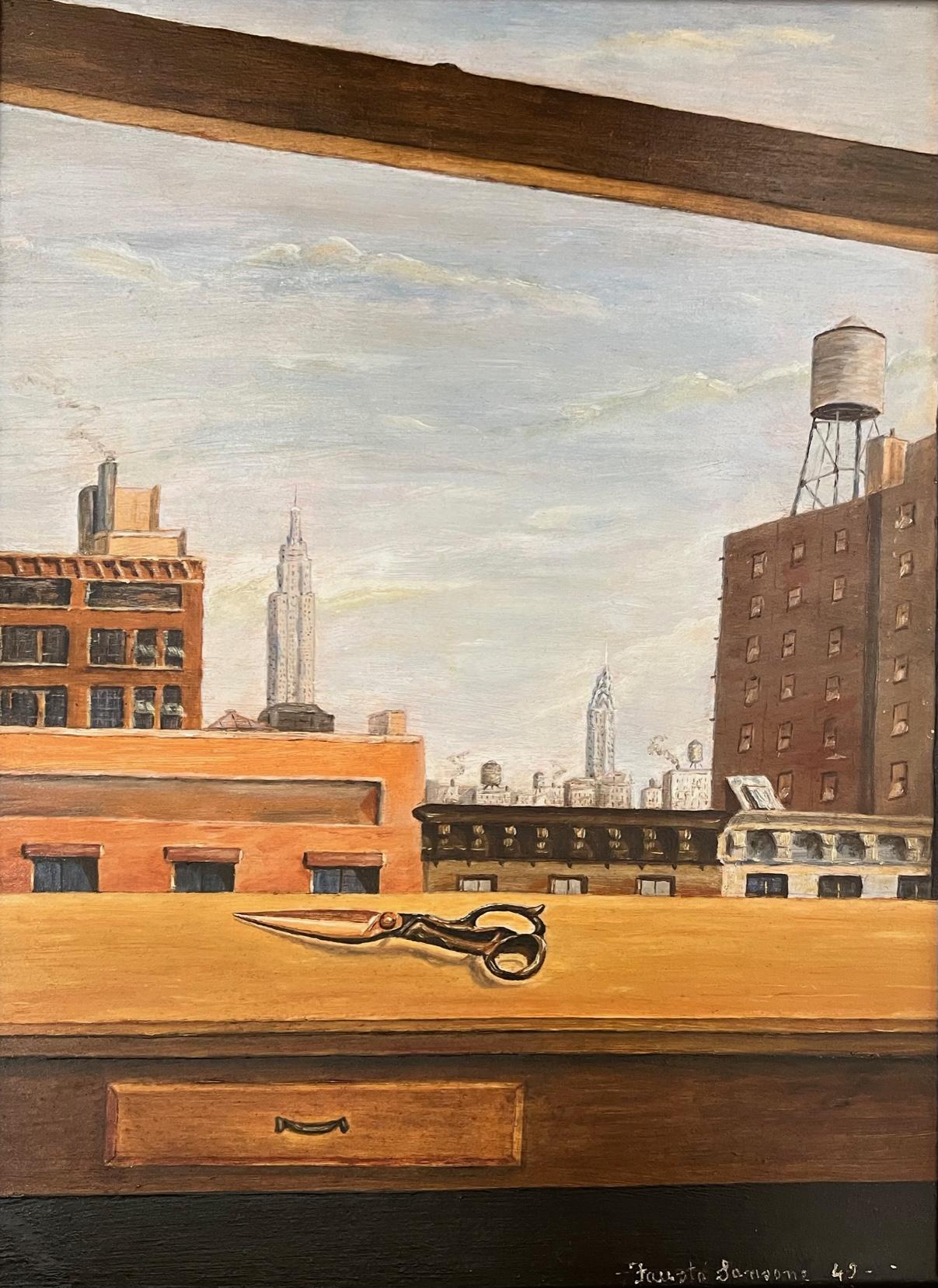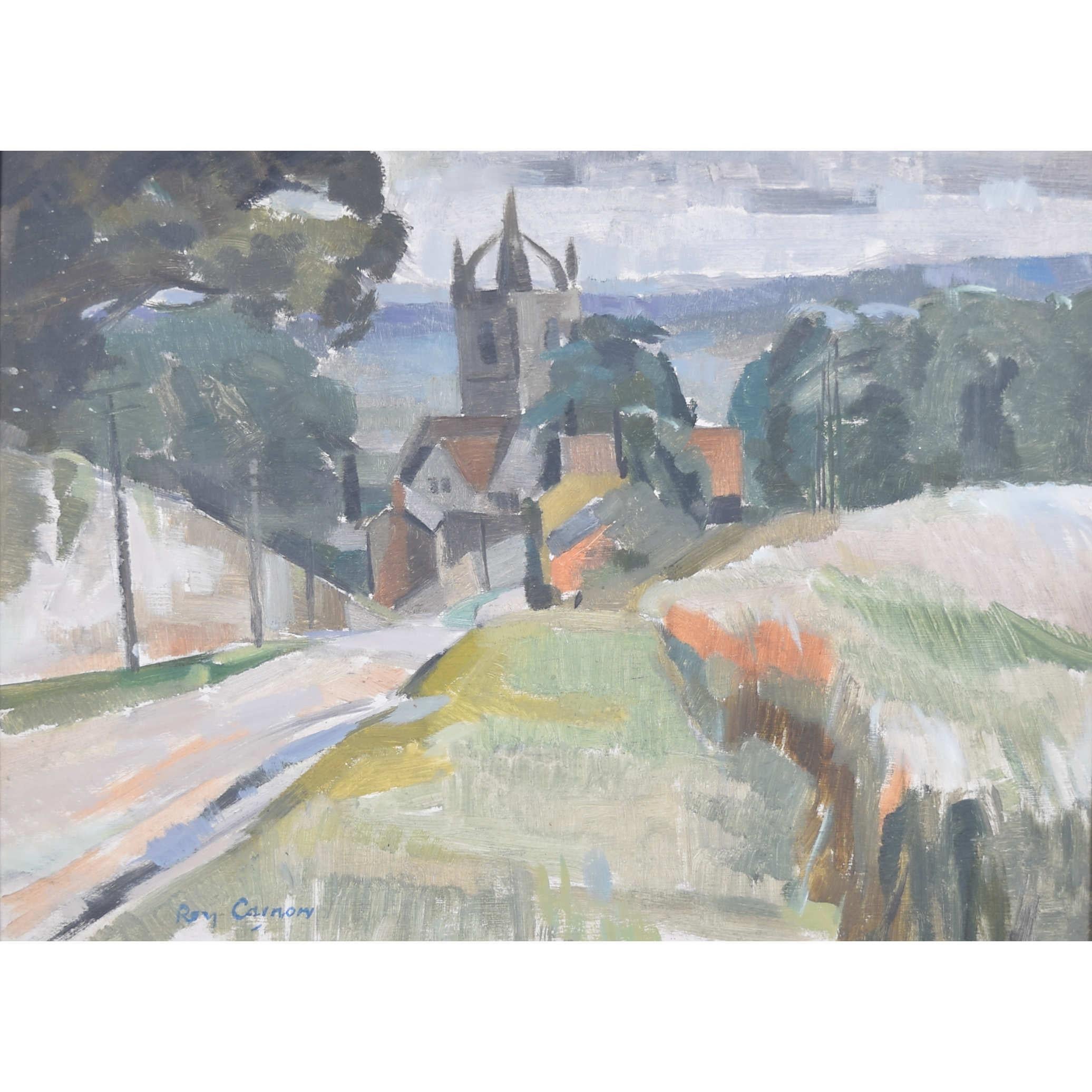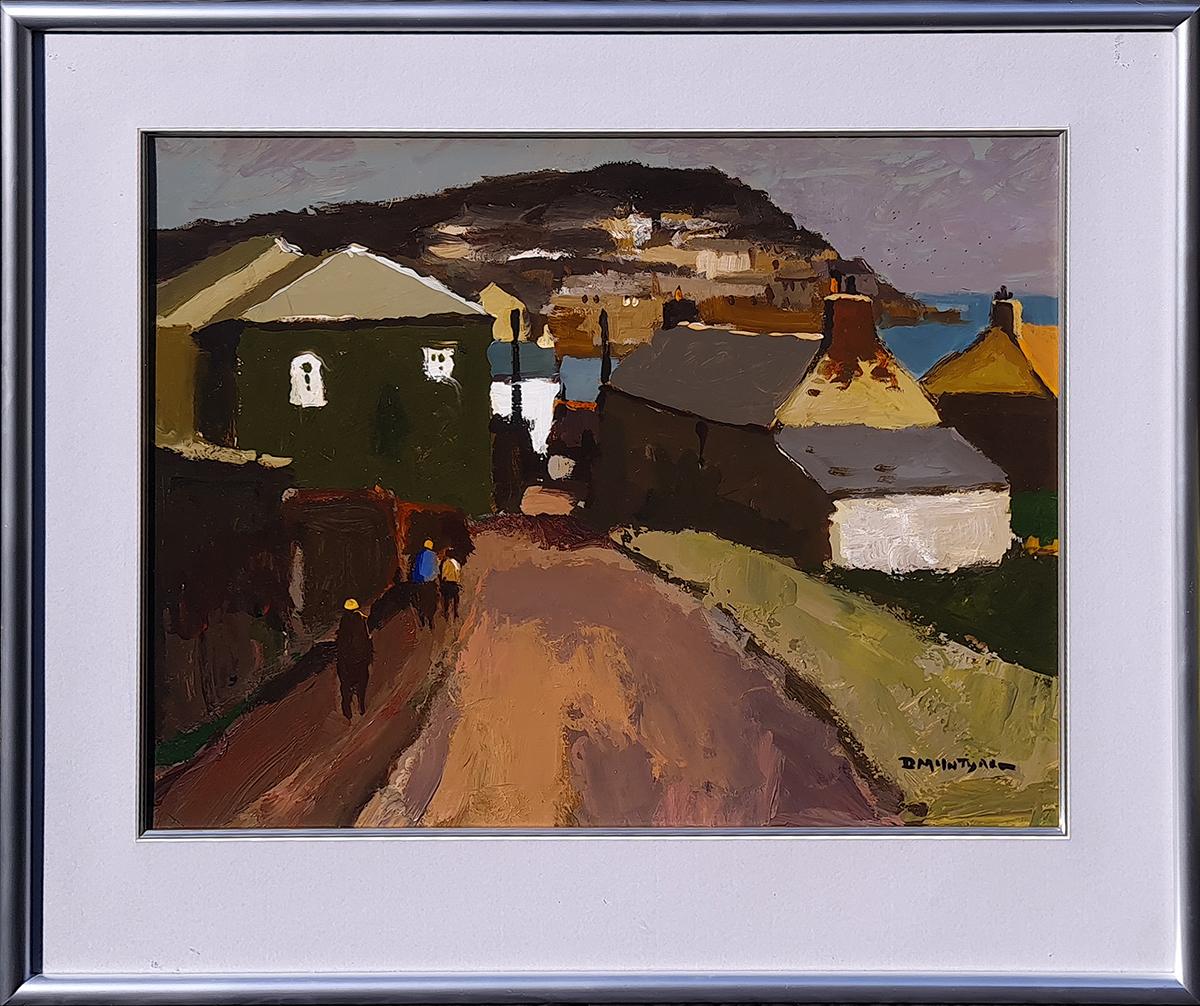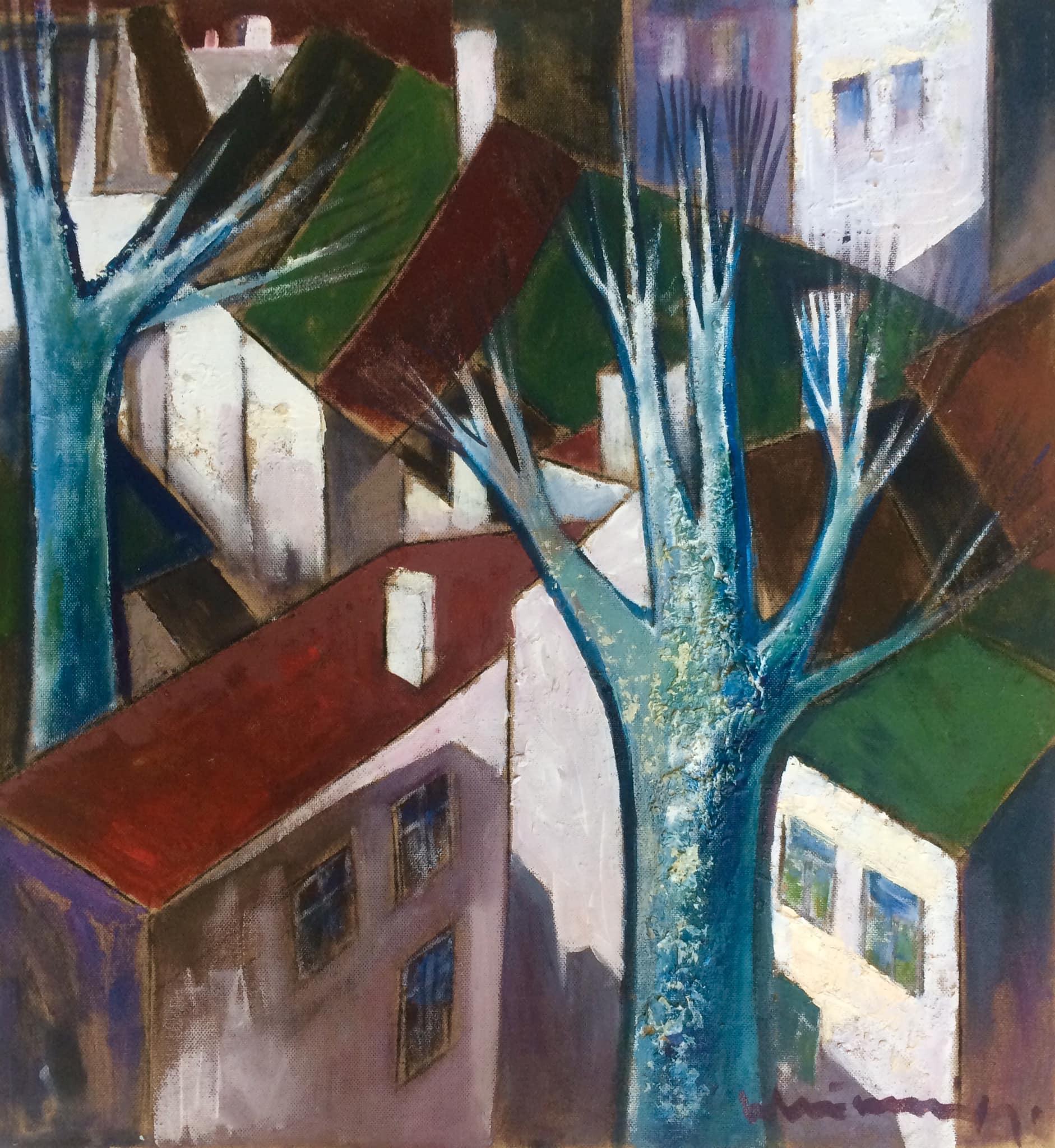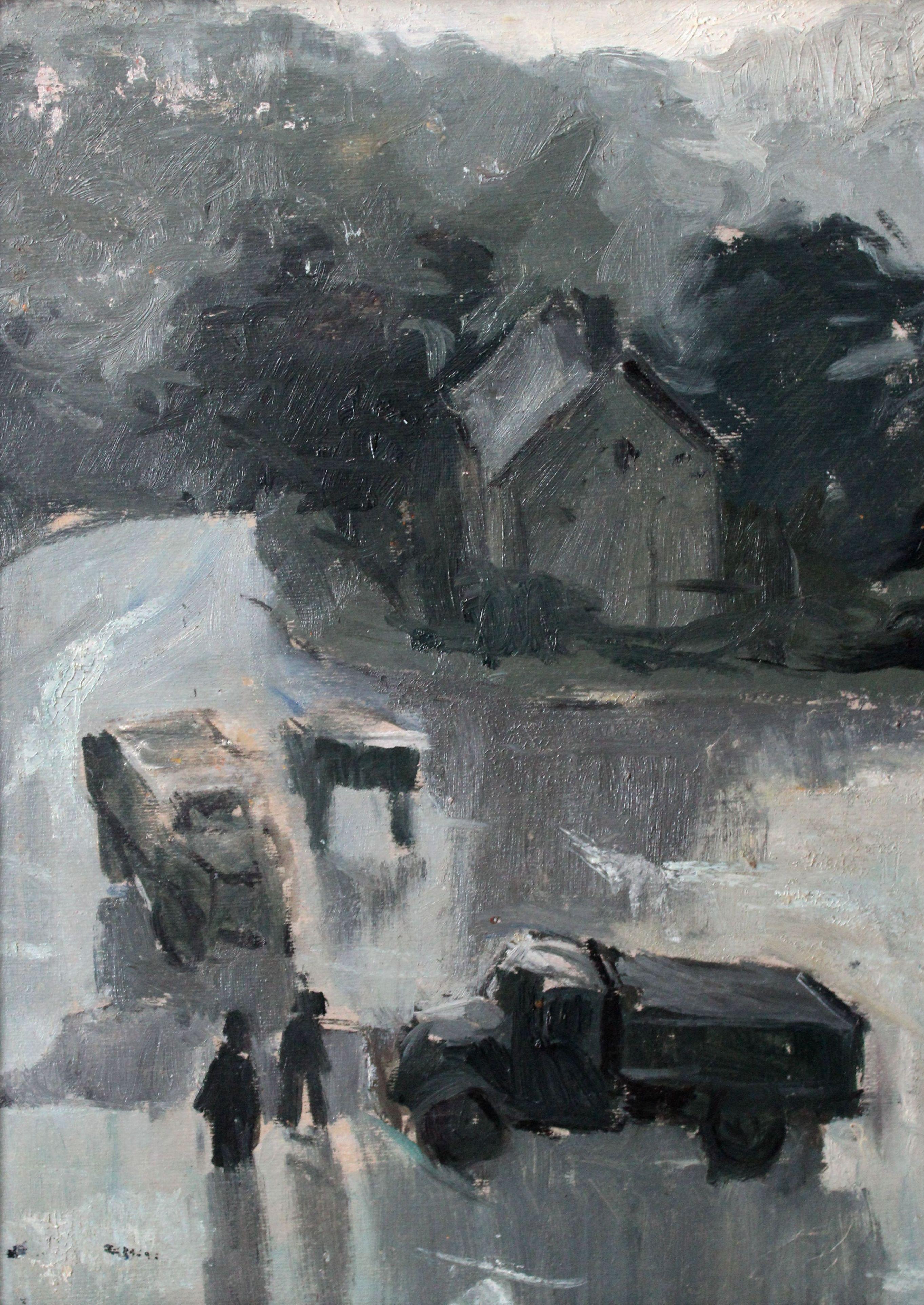Items Similar to Polish Modernist Village landscape in the Snow Oil Painting
Want more images or videos?
Request additional images or videos from the seller
1 of 7
Bronislaw LinkePolish Modernist Village landscape in the Snow Oil Painting
About the Item
Bronisław Wojciech Linke, (born 23 April 1906 in Tartu, Estonia, died 6 October 1962 in Warsaw, Poland), was a painter and graphic artist noted for his metaphorical realism in his depiction of human destructiveness.
He was born into the Polish community in Estonia, the son of a notary, Juliusz Ferdynand Linke and Maria, née Starorypińska. In 1919 the family were 'repatriated' to Poland and settled in Kalisz, a town destroyed in 1914.
He began his art studies in the Bydgoszcz School of Industrial Art 1922–1923. He spent the next two years in the Kraków Art School, followed by five years at the Warsaw Academy of Art 'ASP', under the direction of Tadeusz Pruszkowski. He joined the 'Wolnomalarska Lodge' (a painterly pun in Polish on freemasonry) and was a member of the „Powiśle” group before and after the Second world war.
His début as a graphic artist was in the columns of the satirical review, Szpilki in 1936. He contributed illustrations to such publications as Dziennik Ludowy, Nowe Życie, Sygnały, Tygodnik Robotnika, and after the war to Polityka and Trybuna Ludu.
As an artist, he worked in thematic periods. His earliest such period of drawings took the title, War (1931–1932), followed by a series called Miasto, 'the City' (1931–1935).
He was a friend of Stanisław Witkiewicz with whom he made a trip to Silesia. The result was a series of 30 drawings under the heading of Śląsk. In May 1938 an exhibition of these latest works in the Instytut Propagandy Sztuki (Institute for the Propagation of Art) was shut down on account of its potentially 'pernicious social effects'.
After the outbreak of World War II, he was forced to flee with his wife and they went to Lwów, for fear of Nazi reprisals for his cartoons of Adolf Hitler that had appeared in the press. In 1942 he was exiled to Orsk in the Ural Federal District. Only in 1946 was he able to return to Poland from there.
On his return to Warsaw he painted his most celebrated Screaming Stones series (1946-56). It was a terrifying vision of the capital in ruins. The work was eponymously published in 1959 with an introduction by Maria Dąbrowska. After the war he exhibited rarely as his work did not cohere with the then prevailing political climate. He was widowed and remarried before the war. There were no children. Linke died of cancer and is buried in Powązki Military Cemetery in Warsaw.
Linke's creativity is often characterized as metaphorical realism. His art is based on visualisations, as it were depictions of literary metaphor. Both the composition of individual works and the structure of his series rest on an evident narrative approach. Most of his work is on paper with the use of Water colour, Gouache, Crayon, pencil or Indian ink. He often scraped the surface of the paper and applied Collage. One of his most famous and late works is the Bus, a palpable reference to Stanisław Wyspiański's play, Wesele, The Wedding. As in the drama, so the figures on the Bus can be seen as slaves who stand in the way of their own liberation. A song, Czerwony autobus was inspired by the painting. In 1981 the poet Jacek Kaczmarski was further inspired by the same painting to write a poem Kanapka z człowiekiem.Another noted Linke work is „Modlitwa zamordowanych”, Prayer of the Murdered from 1942.
In 1991 Grzegorz Dubowski directed a documentary film entitled, Bronisława Linkego opisywanie świata, 'The World as described by Bronisław Linke'.
- Creator:Bronislaw Linke (1906 - 1962, Polish)
- Dimensions:Height: 19.5 in (49.53 cm)Width: 23 in (58.42 cm)
- Medium:
- Movement & Style:
- Period:
- Condition:warping to board.
- Gallery Location:Surfside, FL
- Reference Number:1stDibs: LU38212571692
About the Seller
4.9
Platinum Seller
These expertly vetted sellers are 1stDibs' most experienced sellers and are rated highest by our customers.
Established in 1995
1stDibs seller since 2014
1,555 sales on 1stDibs
Typical response time: 1 hour
- ShippingRetrieving quote...Ships From: Surfside, FL
- Return PolicyA return for this item may be initiated within 3 days of delivery.
More From This SellerView All
- Jerusalem Tower of David, Sabra, Israeli British Modernist Impasto Oil PaintingBy Ruth ThomasLocated in Surfside, FLEarly modernist Israeli Judaica painting, by British mid-century artist. Israel Old City of Jerusalem scene.Category
Mid-20th Century Modern Landscape Paintings
MaterialsOil, Board
- Simka Simkhovitch WPA Artist Oil Painting Gouache American Modernist PowerlineBy Simka SimkhovitchLocated in Surfside, FLSimka Simkhovitch (Russian/American 1893 - 1949) This came with a small grouping from the artist's family, some were hand signed some were not. These were studies for larger paintings. Simka Simkhovitch (Симха Файбусович Симхович) (aka Simka Faibusovich Simkhovich) (Novozybkov, Russia May 21, 1885 O.S./June 2, 1885 N.S.—Greenwich, Connecticut February 25, 1949) was a Ukrainian-Russian Jewish artist and immigrant to the United States. He painted theater scenery in his early career and then had several showings in galleries in New York City. Winning Works Progress Administration (WPA) commissions in the 1930s, he completed murals for the post offices in Jackson, Mississippi and Beaufort, North Carolina. His works are in the permanent collections of the Dallas Museum of Art, the National Museum of American Art and the Whitney Museum of American Art. Born outside Kyiv (Petrograd Ukraine) into a Jewish family who owned a small department store. During a severe case of measles when he was seven, Simcha Simchovitch sketched the views outside his window and decided to become an artist, over his father's objections. Beginning in 1905, he studied at the Grekov Odessa Art School and upon completion of his studies in 1911 received a recommendation to be admitted to the Imperial Academy of Arts. Though he enrolled to begin classes in architecture, painting, and sculpture at the Imperial Academy, he was dropped from the school roster in December because of the quota on the number of Jewish students and drafted into the army. Simchovitch served as a private in the 175th Infantry Regiment Baturyn [ru] until his demobilization in 1912. Re-enrolling in the Imperial Academy, he audited classes. Simka Simkhovitch exhibited paintings and sculptures in 1918 as part of an exhibition of Jewish artists and in 1919 placed 1st in the competition "The Great Russian Revolution" with a painting called "Russian Revolution" which was hung in the State Museum of Revolution. In 1922, Simkha Simkhovitch exhibited at the International Book Fair in Florence (Italian: Fiera Internazionale del Libro di Firenze). In 1924, Simkhovitch came to the United States to make illustrations for Soviet textbooks and decided to immigrate instead. Initially he supported himself by doing commercial art and a few portrait commissions. In 1927, he was hired to paint a screen for a scene in the play "The Command to Love" by Fritz Gottwald and Rudolph Lothar which was playing at the Longacre Theatre on Broadway. Art dealers began clamoring for the screen and Simkhovitch began a career as a screen painter for the theater. Catching the attention of the screenwriter, Ernest Pascal, he worked as an illustrator for Pascal, who then introduced him to gallery owner, Marie Sterner. Simkhovitch's works appeared at the Marie Sterner Gallery beginning with a 1927 exhibit and were repeated the following year. Simkhovitch had an exhibit in 1929 at Sterner's on circus paintings. In 1931, he held a showing of works at the Helen Hackett Gallery, in New York City and later that same year he was one of the featured artists of a special exhibit in San Francisco at the California Palace of the Legion of Honor in Lincoln Park. The exhibit was coordinated by Marie Sterner and included four watercolors, including one titled "Nudes". He is of the generation of Russian Soviet artists such as Isaac Pailes, Serge Charchoune, Marc Chagall, Chana Orloff, Isaac Ilyich Levitan, and Ossip Zadkine. In 1936, Simkhovitch was selected to complete the mural for the WPA Post office project in Jackson, Mississippi. The mural was hung in the post office and courthouse in 1938 depicted a plantation theme. Painted on the wall behind the judge’s bench, “Pursuits of Life in Mississippi”, a depiction of black workers engaged in manual labor amid scenes of white professionals and socialites, was eventually covered over in later years during renovations due to its stereotypical African American imagery. Simka painted what he thought was typical of Jackson. His impression of pre-civil rights Mississippi was evidently Greek Revival column houses, weeping willow trees, working class families, and the oppression of African Americans. He painted African American men picking cotton, while a white man took account of the harvest and a white judge advised a white family, calling it Pursuits of Life in Mississippi. Though clearly endorsed by the government and initially generally well-received, the mural soon raised concerns with locals as the climate toward racial segregation began to change. The main concern was whether depictions that show African Americans in subjugated societal roles should be featured in a courtroom. The following year, his painting "Holiday" won praise at an exhibition in Lincoln, Nebraska. In 1940, Simkhovitch's second WPA post office project was completed when four murals, "The Cape Lookout Lighthouse and the Orville W. Mail Boat", "The Wreck of the Crissie Wright", "Sand Ponies" and "Canada Geese" were installed in Beaufort, North Carolina. The works were commissioned in 1938 and did not generate the controversy that the Jackson mural had. The main mural is "The Wreck of the Crissie Wright" and depicts a shipwreck which had occurred in Beaufort in 1866. "The Cape Lookout Lighthouse and the Orville W. Mail Boat" depicted the lighthouse built in 1859 and the mail boat that was running mail during the time which Simkhovitch was there. The boat ran mail for the area until 1957. "Sand Ponies" shows the wild horses common to the North Carolina barrier islands and "Canada Geese" showed the importance of hunting and fishing in the area. All four murals were restored in the 1990s by Elisabeth Speight, daughter of two other WPA muralists, Francis Speight...Category
1930s American Modern Landscape Paintings
MaterialsGouache, Oil, Board
- Simka Simkhovitch WPA Artist Oil Painting American Modernist Landscape Pond TreeBy Simka SimkhovitchLocated in Surfside, FLSimka Simkhovitch (Russian/American 1893 - 1949) This came with a small grouping from the artist's family, some were hand signed some were not. Thes...Category
1930s American Modern Landscape Paintings
MaterialsOil, Board
- Simka Simkhovitch WPA Artist Oil Painting American Modernist Landscape w TowerBy Simka SimkhovitchLocated in Surfside, FLSimka Simkhovitch (Russian/American 1893 - 1949) This came with a small grouping from the artist's family, some were hand signed some were not. Thes...Category
1930s American Modern Landscape Paintings
MaterialsOil, Board
- Abstract Landscape 1954 American Modernist from Paul Rosenberg GalleryBy Raymond MintzLocated in Surfside, FLLabel verso from Paul Rosenberg Gallery. (this was 600$ in 1954!) 18 X 26 without frame. 19 X 27.75 with frame Raymond was born in Clifton, New Jersey, in 1925, of German descent. ...Category
Mid-20th Century Modern Landscape Paintings
MaterialsOil, Board
- Family of Farmers by the BarnLocated in Surfside, FLBarn in a serene landscape, oil painting.Category
20th Century Modern Landscape Paintings
MaterialsOil, Board
You May Also Like
- My Only Working ToolLocated in Los Angeles, CAMy Only Working Tool, 1949, oil on panel, signed and dated lower right, 16 x 12 inches, remnant of exhibition label verso, exhibited at the Art News Second Annual National Amateur Co...Category
1940s American Modern Paintings
MaterialsOil, Board
- Roy Carnon: 'All Hallows Church, Tillington, near Petworth' oil paintingLocated in London, GBTo see our other Modern British Art, scroll down to "More from this Seller" and below it click on "See all from this Seller" - or send us a message if you cannot find the artist you want. Roy Carnon...Category
Mid-20th Century Modern Landscape Paintings
MaterialsBoard, Oil
- Derelict Catalina Flying Boats Roy Carnon oil painting Redhills Lake near MadrasLocated in London, GBTo see our other Modern British Art and World War 2 art, scroll down to "More from this Seller" and below it click on "See all from this Seller" - or s...Category
1940s Modern Landscape Paintings
MaterialsOil, Board
- Mousehole, CornwallBy Donald McIntyreLocated in Belgravia, London, LondonOil on board Board size: 19.5 x 24.5 inches Framed size: 28.5 x 32.5 inches Signed lower rightCategory
21st Century and Contemporary Modern Landscape Paintings
MaterialsOil, Board
- Roofs. 1991, oil on cardboard 91x85 cmLocated in Riga, LVLaimdots Murnieks had a significant influence on the development of Latvian painting at the end of the 20th century. His work 'Holiday' conveys the feeling lightness and joy, which i...Category
1990s Modern Landscape Paintings
MaterialsOil, Cardboard
- In the evening, 1950's, oil on cardboard, 46, 5х34 cmLocated in Riga, LVIn the evening, 1950-ties, cardboard, oil, 46,5х34 cm Anatoly Lebedev (1935-2014)Category
1950s Modern Landscape Paintings
MaterialsOil, Cardboard
Recently Viewed
View AllMore Ways To Browse
Polish Art Vintage
Industrial Landscape Paintings
Vintage Landscape Illustration
Poland Landscape
Landscape Of Poland
Indian Landscape Painting
Satirical Painting
Wedding In Paintings
Retro Landscape Illustration
Landscape Ruins
Polish Artist Landscape
Painting Of Polish Landscape
Landscape With Ruins
Warsaw Landscape
Oil Painting Indian Landscape
Ruins Landscape Painting
Oil Painting Snow In Cities
Painting Z
